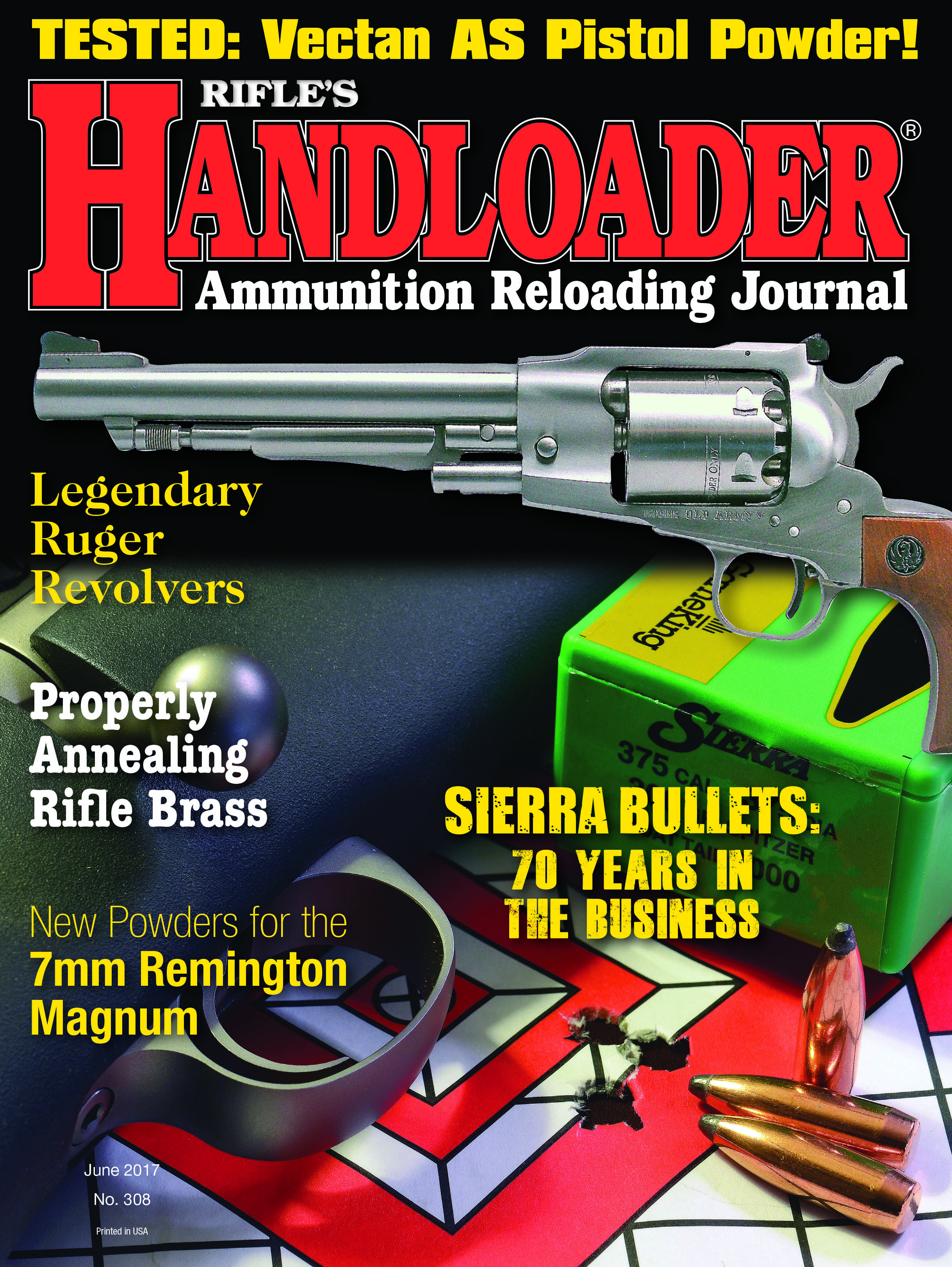Annealing Rifle Brass
Accuracy-Improving Tips and Techniques
feature By: John Barsness | June, 17
The primary reason for annealing rifle brass is to prevent case necks from cracking – and they will, eventually, because firing and resizing cases “work hardens” brass, making the thin necks brittle. Most rifle cases will survive four or five firings, and some will last longer, depending on the brand and method of resizing. Many handloaders avoid the issue entirely by retiring brass after several firings.
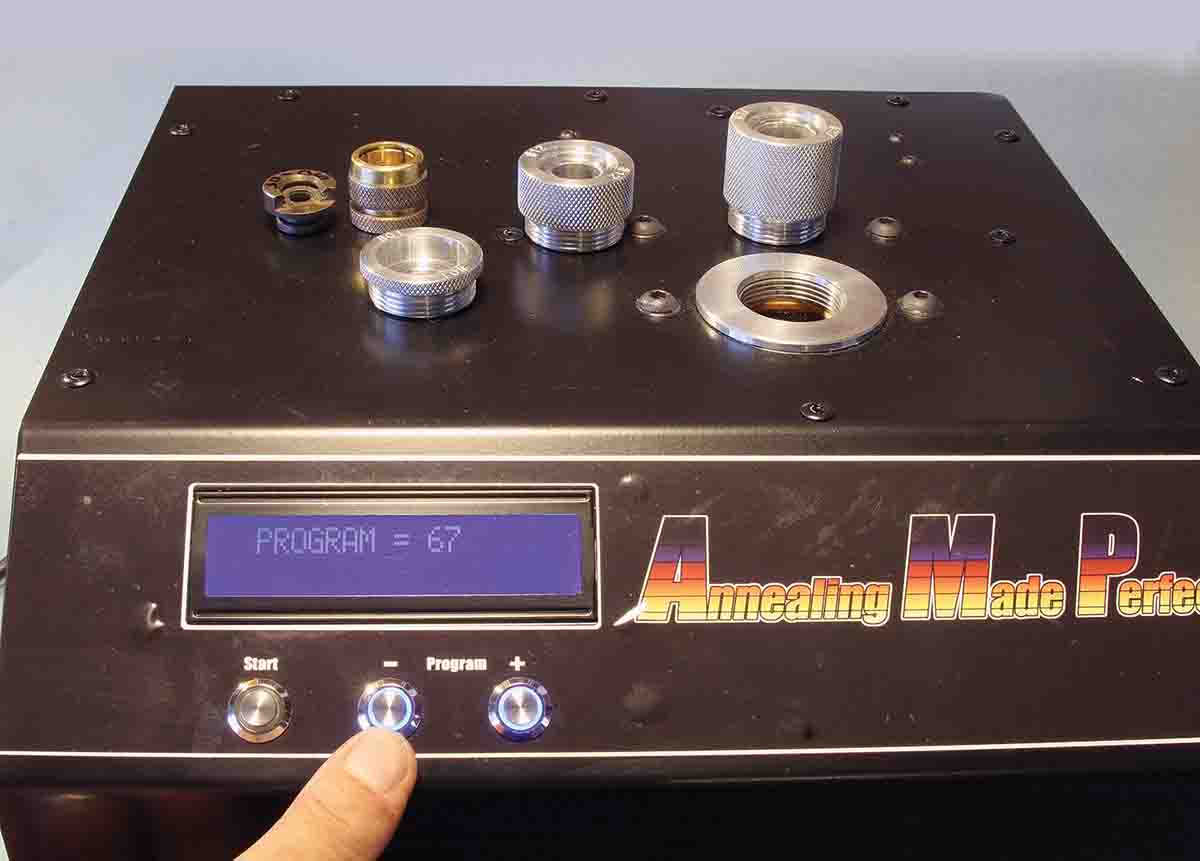
Some companies that sold bulk brass also happened to be major ammunition manufacturers. When demand for ammunition rose, they found it more sensible to use new cases to make ammunition. As a result, it wasn’t always possible to buy a batch of new brass, so many handloaders decided to make their old brass last longer. This coincided with an ongoing trend toward handloading for finer accuracy, whether because more shooters started competing in a target game, shot at longer ranges or

I started annealing before the recent shortages, primarily due to fooling with wildcat cartridges. Forming wildcat cases required both time and, often, the expense of fireforming, but I was somewhat startled to find that annealing wasn’t very complicated or time-consuming. This surprise was due to the standard misinformation published for many years, which went something like this: “Stand your fired cases in a metal pan, then pour enough cold water into the pan to cover everything but the shoulders and necks. Heat the brass with a torch until it glows red, then knock the cases over into the water, quenching the hot brass to finish the annealing process.”
It may date me some to admit this, but that was the standard advice back when I started handloading, regurgitated countless times in shooting magazines and loading manuals. While some handloaders still anneal cases that way, there are several problems with the technique, including being unnecessarily complicated.
Cartridge brass averages around 70 percent copper and 30 percent zinc, though that can vary somewhat, and brass often contains tiny amounts of other elements. This alloy is strong enough to contain pressures of over 60,000 pounds per square inch, is flexible enough to seal the rear of the chamber and to hold bullets firmly yet release them smoothly.
The final hardness of a new case also depends on the work-hardening caused during forming at the factory. Work-hardening is essential to the thick head of a rifle case, the portion that contains pressure, but makes the thin neck brittle, the reason cartridge manufacturers anneal necks after the final forming.
No manufacturer I’m acquainted with heats the necks until they glow red, because any hint of red indicates a temperature of around 800 degrees Fahrenheit. Zinc melts at 787 degrees – more than 1,000 degrees below the melting point of copper. Overheating brass can actually melt out some zinc, turning the brass permanently soft. That’s the primary problem with the old annealing technique, but heated brass also doesn’t require quenching to remain soft. If there is a need to reload the quenched cases posthaste, their insides have to be dried, but they cool pretty quickly if simply left standing in water. (Of course, if the cases are decapped before standing them in water, they’re going to be wet inside anyway.)
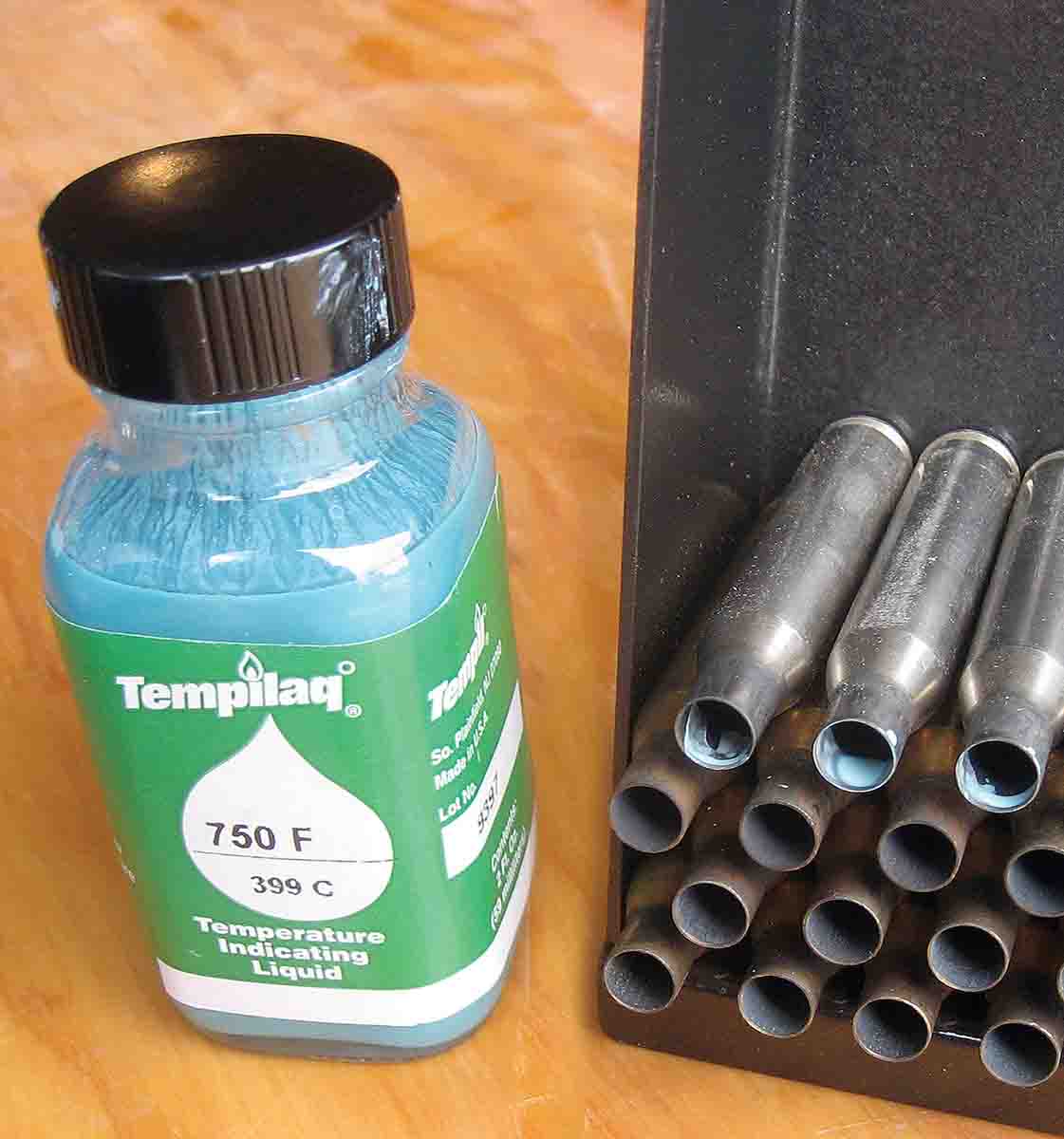
Annealing really doesn’t require standing the cases in water, and torching a pan full of brass tends to heat the necks unevenly, no matter how nimbly a handloader moves the torch around. Annealing also enhances accuracy by allowing bullets to leave necks more consistently, but a neck softer on one side tends to tilt bullets slightly as they start down the bore.
Annealing brass also doesn’t involve heating to a single, precise temperature. In a way it’s like cooking pork: Many people “know” pork needs to be heated to 160 degrees Fahrenheit to kill trichinella larvae, but 160 degrees is merely the temperature that kills the larvae within seconds. Cooking pork to somewhat lower temperatures for longer periods also whacks ’em.
Similarly, brass anneals at temperatures as low as 480 degrees, but the process takes longer. Even annealing at 600 degrees requires an hour – far too long for most handloaders’ purposes. Instead, we want to quickly heat necks to just under the melting temperature of zinc, thereby avoiding the problem of heating the rest of the case, annealing the head.
Luckily, this isn’t difficult, since heat-testing paints are easily available, and a small bottle lasts a long time. There are several brands, but the one I’ve used most is Tempilaq’s 750-degree paint. Dab a little inside the case mouth, heat the neck just until the color disappears, and the neck is annealed. Most handloaders, however, don’t paint the inside of every neck. Instead they paint maybe five cases, then count how long it takes to disappear after applying the heat source. After that, they heat unpainted necks for the same count.
The simplest and least expensive annealing method I’ve ever encountered was devised by my friend Fred Barker, who published his results in the now-defunct magazine Precision Shooting. Fred sent me a copy of the article years ago, and I’ve used his technique with fine results ever since.
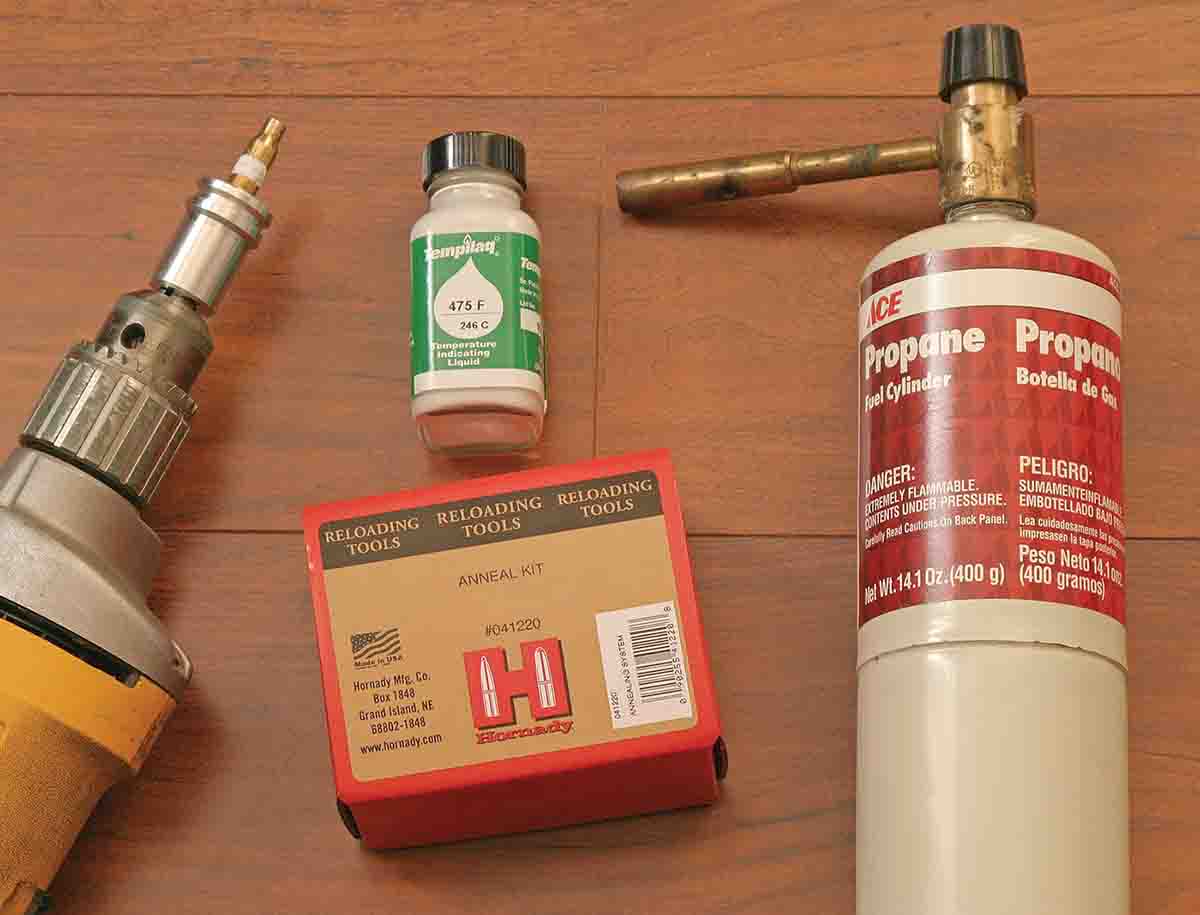
Fred knew that a candle’s flame is far hotter than the annealing point of brass, so he applied heat-paint to the necks of various cartridge cases and started experimenting. He found that holding a case in his fingertips about halfway up the body, then placing the neck in the tip of a candle’s flame and turning it back and forth until the case grew too hot to hold, heated the brass to just about the right temperature. When his fingertips got hot, he’d drop the case on a wet towel, then use the towel to wipe the candle-soot from the outside. Presto, annealed case!
I’ve found candle annealing usually takes about 10 seconds on cases the size of the .308 Winchester or .30-06 and slightly longer on full-sized magnums. Add another five seconds to wipe off the case, and the annealing rate is about four cases a minute, so 20 cases can be done in five minutes. Since the “set-up time” of lighting a candle and wetting a paper towel is minimal, this is how I anneal most of my big-game rounds. It works a little faster on smaller cases, taking about 6 to 7 seconds on .22 Hornets. With care it can also be used with a propane torch, which doesn’t produce soot so bypasses the need to wipe off the cases, but I’m still not going to finger-anneal 500 Hornet cases.
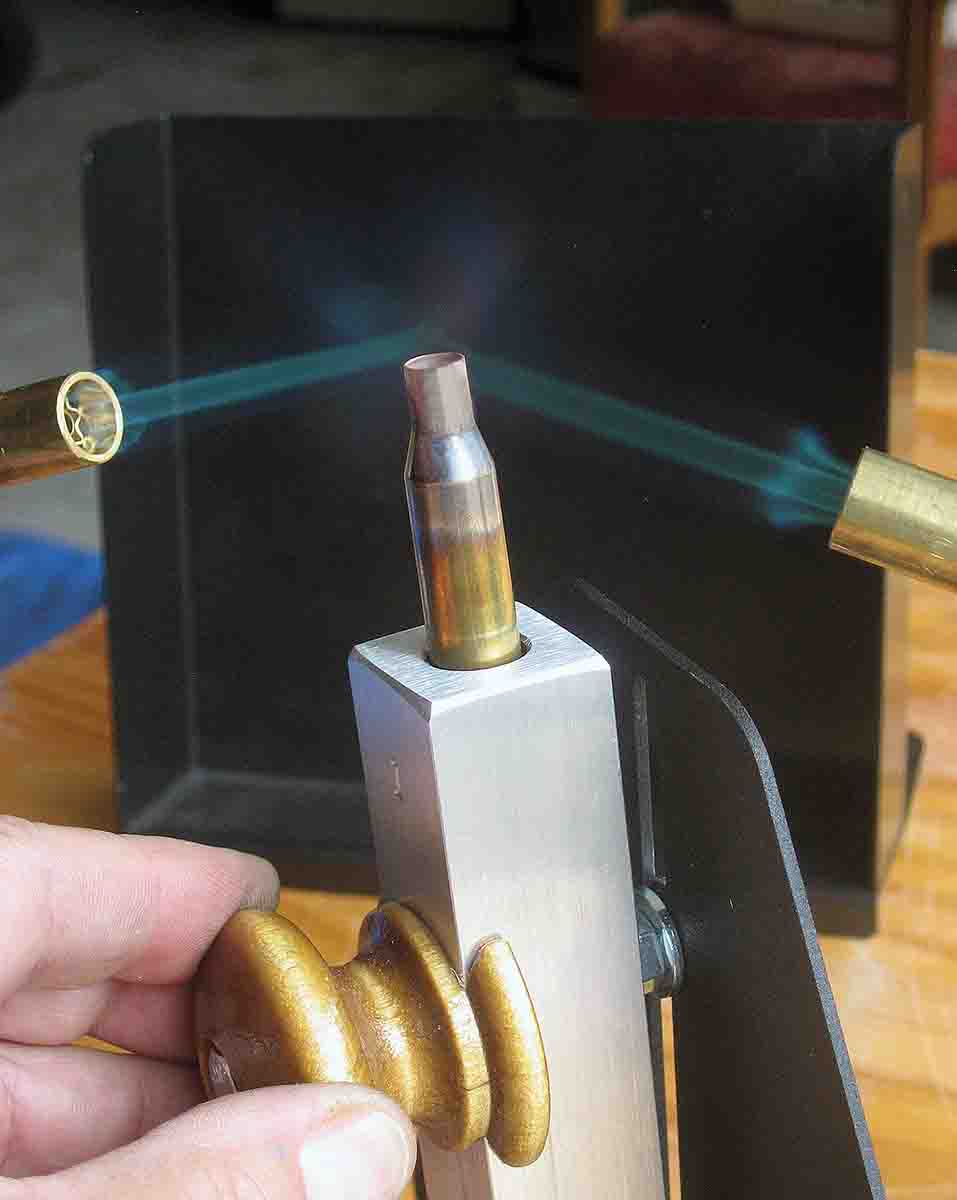
For around $100 there’s the Anneal-Rite (PO Box 180994, Fort Smith AR 72918; www.cartridgeanneal.com), an arrangement that looks something like a small windmill with a double-ended, hand-turned socket to speed up the process, plus stands for a pair of propane torches (not included). The torches are set up opposite each other, heating the necks evenly and quickly. In my experience, the Anneal-Rite cuts at least a third of the time from annealing cases individually but takes longer to set up.
Several companies offer more sophisticated gas-flame annealing tools, often with electric motors and timers, starting at several hundred dollars. However, the most precise annealing tool I’ve tested is a model called the A.M.P., which surrounds the neck and shoulder with electric heat (Annealing Made Perfect, PO Box 305, 9055 W. Wolcott Industrial Pkwy., Wolcott IN 47995; www .ampannealing.com). The A.M.P. was developed in New Zealand, a country with a very high incidence of rifle loonies, and set-up is almost as quick as lighting a candle. Plug it in, then set the program by pressing a couple of buttons. There’s an accompanying chart for the appropriate program for your cartridge, including the specific brand of brass.
The A.M.P. is supposed to anneal brass so precisely and uniformly that muzzle velocities become more consistent, enhancing accuracy. Testing this claim obviously requires accurate rifles and uniform brass, so I decided to try it with a custom 6mm PPC benchrest rifle and a New Ultra Light Arms .30-06. The Norma brand 6mm PPC brass had already been weight-selected and neck-turned. The .30-06 brass was Nosler, sorted for neck thickness variations of .001 inch or less. After annealing in the A.M.P., average groups and velocity variations with various loads in both rifles shrank slightly but measurably – with one exception.
The manufacturer has found annealing time depends primarily on case neck and shoulder thickness, and my Nosler brass was
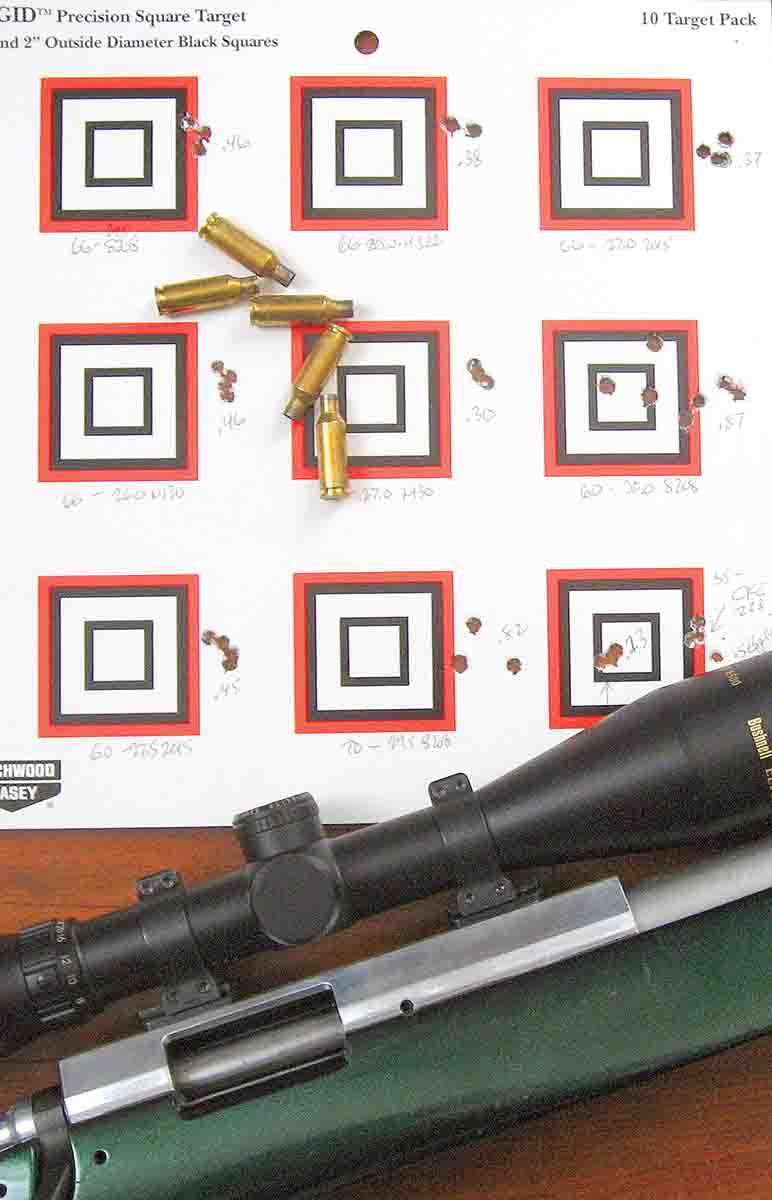
The downside of the A.M.P. is the price of around $1,000, but a number of serious competitive shooters use the machine. I am severely tempted, because not only is the A.M.P. quick and easy to use, but also I often spend $1,000 on a medium-priced rifle, scope, mounts and dies. One less rifle around here wouldn’t make that much difference, but an A.M.P. machine would.
Annealing can even help accuracy with new brass, particularly some of the recent cases that are often rushed out a factory door a little too quickly. My gunsmith friend Charlie Sisk didn’t anneal any brass until 2014, instead buying cases in bulk, loading them once, then selling the once-fired cases at local gun shows. This eliminated sizing and trimming time, allowing Charlie to make more rifles. Then one day he test-fired a just-finished 7mm Remington Magnum a customer had ordered, using a new lot of the same brand of brass he’d used for years, and the rifle shot 2- to 3-inch groups at 100 yards. This was in Charlie’s indoor range, so wind was not a factor, and even after taking the rifle completely apart again, he couldn’t find anything wrong.
So Charlie phoned me, something he occasionally does when really desperate – which is fair, since I sometimes do the same to him. After talking for a while, I found he’d already tried all the standard “stuff” we’d previously discussed many times, like making sure the magazine didn’t contact the action or stock. I finally asked if he’d annealed the brass, discovering he’d never annealed any cases, ever. So I described the candle technique, and the next day Charlie called back, saying I was a genius. I begged to differ, but in this instance the factory apparently had either skipped annealing or hadn’t really leaned into it. After candle-annealing the cases, the rifle immediately started shooting three-shot groups considerably smaller than an inch, exactly what Charlie expected in the first place.
Many competitive shooters anneal their cartridges after every firing, because they want every neck-turned case to release each bullet as precisely the same as possible. I don’t do that with my hunting rifle brass, usually annealing after four firings to prevent cracked necks, but do keep the cases segregated according to how many times they’ve been fired since the last annealing. Along with consistent neck thickness, this definitely helps accuracy, in particular tending to eliminate the mysterious “fliers” sometimes occurring in otherwise normal groups.
Handloaders don’t have to anneal rifle brass, but it sure doesn’t hurt – unless we don’t drop a candle-annealed case quite soon enough.


